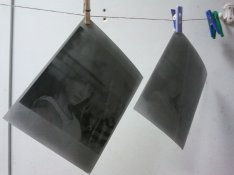jrydberg
Member
- Joined
- Mar 6, 2007
- Messages
- 85
- Format
- Medium Format
Picked up some old paper today. Being a total noob when it comes to printing, i wonder if this old paper (prob from the 60's or 70's) can still be usable? Most boxes hasn't been opened. And is the paper any good?
Here's a list of what I received:
agfa brovira bn2a 3 1/2 x 5 box of 25
agfa brovira bn2a 5 x 7 box of 25
agfa brovira bn2a 7 x 9 1/2 box of 10
agfa brovira bs2a 4 1/8 x 5 7/8 box of 100
agfa brovira bs2a 5 x 7 box of 100
agfa brovira bs2a 5 x 7 box of 25
agfa brovira bs2a 5 x 7 box of 25
agfa brovira bs2a 7 1/8 x 9 1/2 box of 100
agfa brovira bh2a 3 1/2 x 5 box of 100
agfa brovira bh2a 4 1/8 x 5 7/8 box of 25
agfa brovira bh2a 5 x 7 box of 25
agfa brovira bw2a 4 1/8 x 5 7/8 box of 100
agfa brovira bw2a 5 x 7 box of 25
agfa brovira bw2a 7 1/8 x 9 1/2 box of 100
agfa brovira bn112 9 1/2 x 12 box of 10
agfa brovira bn1 3 1/2 x 5 box of 100
agfa brovira bs112 7 1/8 x 9 1/2 box of 10
agfa brovira bs112 9 1/2 x 12 box of 10
agfa brovira beh1 5 x 7 box of 25
agfa record rapid rrs1 5 x 7 box of 100
ilford ilfospeed medium 180 pearl 5x7 box of 25
ilford ilfospeed medium 180 pearl 7x9 1/2 box of 25
Here's a list of what I received:
agfa brovira bn2a 3 1/2 x 5 box of 25
agfa brovira bn2a 5 x 7 box of 25
agfa brovira bn2a 7 x 9 1/2 box of 10
agfa brovira bs2a 4 1/8 x 5 7/8 box of 100
agfa brovira bs2a 5 x 7 box of 100
agfa brovira bs2a 5 x 7 box of 25
agfa brovira bs2a 5 x 7 box of 25
agfa brovira bs2a 7 1/8 x 9 1/2 box of 100
agfa brovira bh2a 3 1/2 x 5 box of 100
agfa brovira bh2a 4 1/8 x 5 7/8 box of 25
agfa brovira bh2a 5 x 7 box of 25
agfa brovira bw2a 4 1/8 x 5 7/8 box of 100
agfa brovira bw2a 5 x 7 box of 25
agfa brovira bw2a 7 1/8 x 9 1/2 box of 100
agfa brovira bn112 9 1/2 x 12 box of 10
agfa brovira bn1 3 1/2 x 5 box of 100
agfa brovira bs112 7 1/8 x 9 1/2 box of 10
agfa brovira bs112 9 1/2 x 12 box of 10
agfa brovira beh1 5 x 7 box of 25
agfa record rapid rrs1 5 x 7 box of 100
ilford ilfospeed medium 180 pearl 5x7 box of 25
ilford ilfospeed medium 180 pearl 7x9 1/2 box of 25









 )
)



